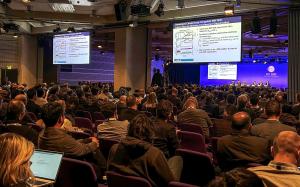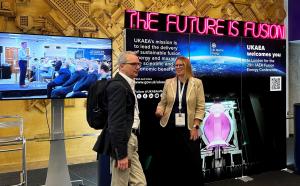At a "crucial moment" in fusion development
The regular chimes of Big Ben sound in the background; the British Parliament is just around the corner. For one week in October London's Westminster City—the bustling political power centre of the United Kingdom—provided the backdrop for a different kind of power, fusion energy, as the 29th IAEA Fusion Energy Conference gathered fusion enthusiasts from all over the world at the Queen Elizabeth II Conference Centre.
"This next leg of the fusion energy journey will get us from experiment to demonstration to commercial fusion energy production," he said as he announced the creation of a new initiative to enhance fusion energy collaboration—the World Fusion Energy Group. The Director General also introduced the IAEA World Fusion Outlook 2023, the first issue of a publication that he is confident will become the "global reference" for authoritative information on fusion energy.
The first-time achievement of a self-heating plasma was the major announcement that kicked off the conference program. Costanza Maggi, a Fellow of the United Kingdom Atomic Energy Agency and former JET Task Force Leader, recounted that one of the most noticeable results of JET's 2021/22 campaign with deuterium and tritium fuel was the first direct observation of a fusion plasma keeping itself hot through alpha heating—where high-energy helium ions (alpha particles) coming out of the fusion reaction transfer their heat to the surrounding fuel mix to keep the fusion process going. "Studying this process under realistic conditions is crucial to developing fusion power plants."
For an entire week, approximately 1,000 participants from over 80 countries—fusion scientists, engineers, policy makers, regulators and entrepreneurs—gathered in London to review recent developments and chart the way to a future with fusion energy. Another 1,600 participants joined online. The conference was organized around 23 technical sessions with over 100 talks and more than 800 poster presentations.
Participants at the conference came from many different fusion initiatives in the world, both public and private, and the range of themes in the scientific sessions—magnetic confinement, inertial fusion, materials science, machine designs, plasma physics and more—reflected this diversity. In several side events, important societal issues were discussed in relation to fusion, such as energy justice, public engagement and pathways to fusion electricity.
One of these side events was organized by Women in Fusion (WiF). At "Creating an Inclusive Fusion Workforce," it was clear that the topic of improving gender equity in fusion resonated with many of the FEC attendees, as there were more than 100 participants from 13 countries. Women in Fusion, launched in July 2022, already has more than 500 members and has launched a mentoring program.
Representatives of public and private fusion initiatives looked at "Pathways to Fusion." They identified a range of issues that need to be addressed to make fusion energy a reality, including collaboration between public and private fusion projects, training the future work force for fusion energy, involving communities—locally and globally—to ensure energy justice, making fusion economically viable, engaging with existing energy companies, and finally addressing the licensing and safety of fusion energy.
As the conference came to a close, the venue of the next conference was revealed: the 30th IAEA Fusion Energy Conference will take place in the ancient city of Xi'an, China. Describing Xi'an as the city of light and eternity, Min Xu from the Southwestern Institute of Physics (SWIP) in China said it was "one of the most historic cities in China, where history resonates in every corner." History will meet the future when the pre-eminent conference on fusion energy comes to the historic setting of Xi'an in 2025.




